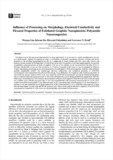

PARTNER
검증된 파트너 제휴사 자료
Influence of Processing on Morphology, Electrical Conductivity and Flexural Properties of Exfoliated Graphite Nanoplatelets-Polyamide Nanocomposites
6 페이지
최초등록일 2016.04.02
최종저작일
2010.12

-
 * 본 문서는 배포용으로 복사 및 편집이 불가합니다.
* 본 문서는 배포용으로 복사 및 편집이 불가합니다.
미리보기
서지정보
· 발행기관 : 한국탄소학회
· 수록지 정보 : Carbon letters / 11권 / 4호
· 저자명 : Wanjun Liu, In-Hwan Do, Hiroyuki Fukushima, Lawrence T. Drzal
영어초록
Graphene is one of the most promising materials for many applications. It can be used in a variety of applications not only as a reinforcement material for polymer to obtain a combination of desirable mechanical, electrical, thermal, and barrier properties in the resulting nanocomposite but also as a component in energy storage, fuel cells, solar cells, sensors, and batteries. Recent research at Michigan State University has shown that it is possible to exfoliate natural graphite into graphite nanoplatelets composed entirely of stacks of graphene. The size of the platelets can be controlled from less than 10 nm in thickness and diameters of any size from sub-micron to 15 microns or greater. In this study we have investigated the influence of melt compounding processing on the physical properties of a polyamide 6 (PA6) nanocomposite reinforced with exfoliated graphite nanoplatelets (xGnP). The morphology, electrical conductivity, and mechanical properties of xGnP-PA6 nanocomposite were characterized with electrical microscopy, X-ray diffraction, AC impedance, and mechanical properties. It was found that counter rotation (CNR) twins crew processed xGnP/PA6 nanocomposite had similar mechanical properties with co-rotation (CoR) twin screw processed or with CoR conducted with a screw design modified for nanoparticles (MCoR). Microscopy showed that the CNR processed nanocomposite had better xGnP dispersion than the (CoR) twin screw processed and modified screw (MCoR) processed ones. It was also found that the CNR processed nanocomposite at a given xGnP content showed the lowest graphite X-ray diffraction peak at 26.5˚ indicating better xGnP dispersion in the nanocomposite. In addition, it was also found that the electrical conductivity of the CNR processed 12 wt.% xGnP-PA6 nanocomposite is more than ten times higher than the CoR and MCoR processed ones. These results indicate that better dispersion of an xGnP-PA6 nanocomposite is attainable in CNR twins crew processing than conventional CoR processing.참고자료
· 없음태그
-
자료후기
Ai 리뷰지식판매자가 등록한 자료는 과제에 적용할 수 있는 유용한 내용이 많아, 큰 도움이 되었습니다. 앞으로도 많은 도움을 받을 수 있기를 기대합니다! -
자주묻는질문의 답변을 확인해 주세요

꼭 알아주세요
-
본 학술논문은 (주)코리아스칼라와 각 학회간에 저작권계약이 체결된 것으로 AgentSoft가 제공 하고 있습니다.
본 저작물을 불법적으로 이용시는 법적인 제재가 가해질 수 있습니다. -
해피캠퍼스는 구매자와 판매자 모두가 만족하는 서비스가 되도록 노력하고 있으며, 아래의 4가지 자료환불 조건을 꼭 확인해주시기 바랍니다.
파일오류 중복자료 저작권 없음 설명과 실제 내용 불일치 파일의 다운로드가 제대로 되지 않거나 파일형식에 맞는 프로그램으로 정상 작동하지 않는 경우 다른 자료와 70% 이상 내용이 일치하는 경우 (중복임을 확인할 수 있는 근거 필요함) 인터넷의 다른 사이트, 연구기관, 학교, 서적 등의 자료를 도용한 경우 자료의 설명과 실제 자료의 내용이 일치하지 않는 경우
“Carbon letters”의 다른 논문도 확인해 보세요!
-
Fabrication and Electrical, Thermal and Morphological Properties of No.. 8 페이지
-
New Application of Clay Filler for Carbon/Carbon Composites and Improv.. 5 페이지
-
Functionalization of Multi-walled Carbon Nanotube by Treatment with Dr.. 6 페이지
-
Formation of Isotropic Carbon Matrix in Carbon/Carbon Composites Deriv.. 7 페이지
-
Influence of Glycidyl Methacrylate Grafted Multi-walled Carbon Nanotub.. 5 페이지
문서 초안을 생성해주는 EasyAI
